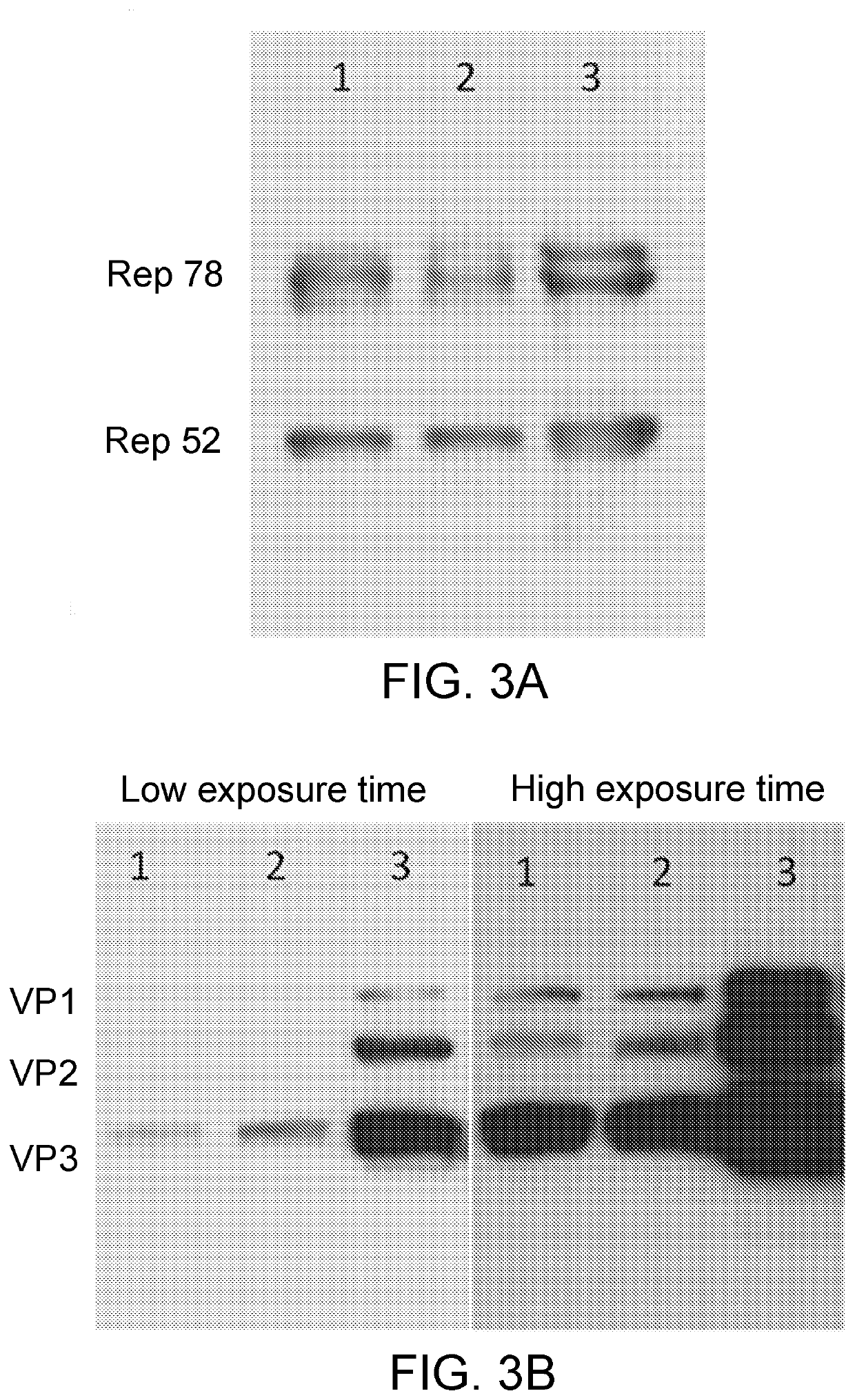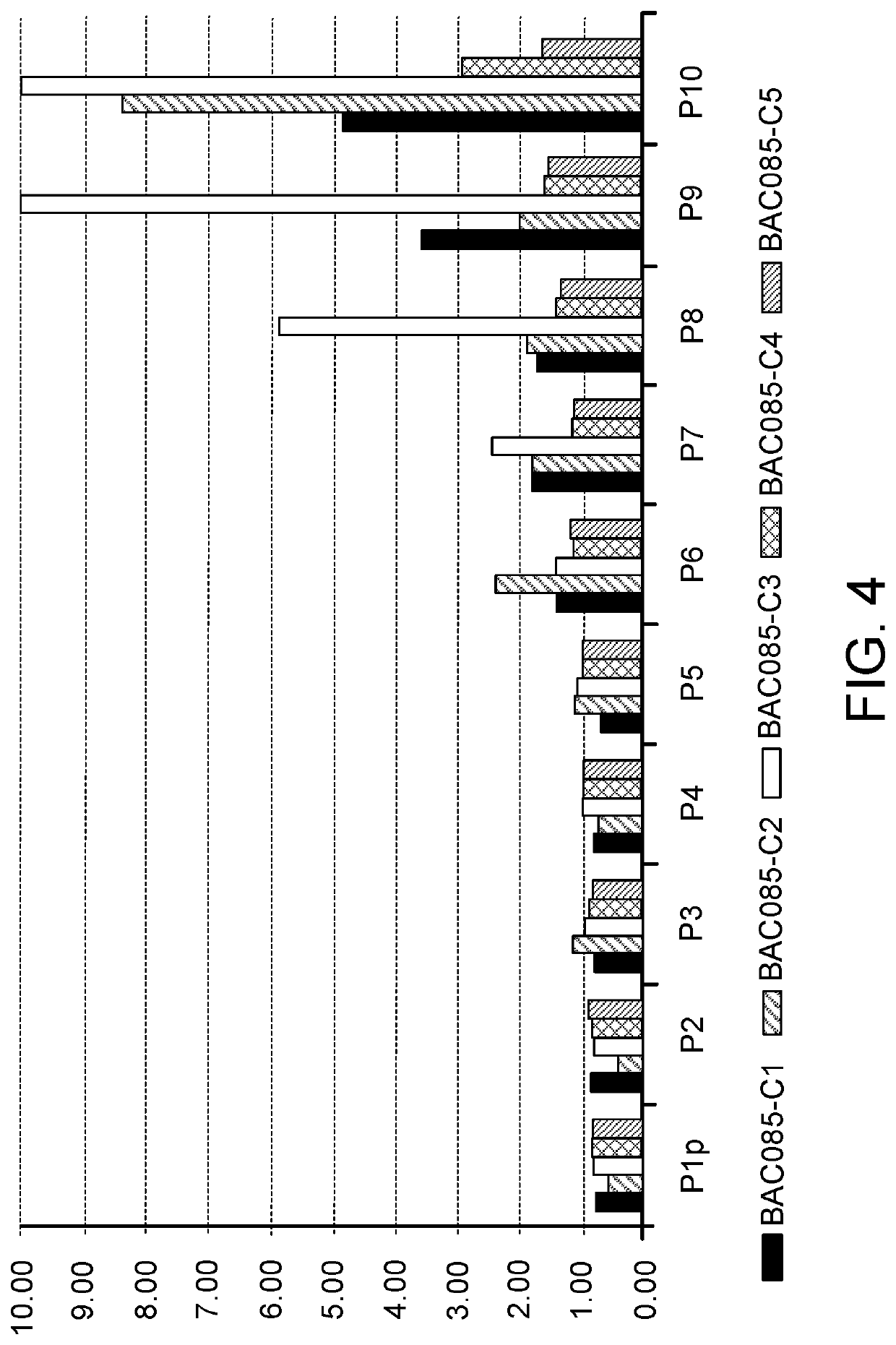Production of adeno-associated viruses in insect cells
a technology of insect cells and adeno-associated viruses, which is applied in the direction of viruses/bacteriophages, dsdna viruses, peptide sources, etc., can solve the problems of largely failing to predict the response of aav capsid, challenging the amplification of mammalian cells in suspension systems,
- Summary
- Abstract
- Description
- Claims
- Application Information
AI Technical Summary
Benefits of technology
Problems solved by technology
Method used
Image
Examples
example 1
ion of the AAV-Anc80L65 Vectors
[0299]1.1. Plasmid Cloning
[0300]Two DNA fragments, named P10-CapAnc80L65start_OPT (SEQ ID NO. 30) and P10-CapAnc80L65start_IntronP10 (SEQ ID NO:31), were synthesized (Genewiz (NJ, USA)) and cloned in pUC57-Kan plasmid. In SEQ ID NOs: 1 and 2 shown below, BstZ17I, BsiWI and NsiI enzymatic sites used for further cloning are underlined in italic letters, and mutations in the Anc80L65-L0065 cap coding sequence (CDS) are indicated by bold underlined letters. In SEQ ID NO:2, the intron-P10 sequence is highlighted in grey.
[0301]1.1.1. OptMin Construct
[0302]The donor plasmid 664_pSR Rep2CapAnc80L65_Opt (illustrated in FIG. 7) contains the ancestral cap CDS Anc80L65-L0065 optimized for the expression in Sf9 insect cell line (CapAnc80L65_Opt), under the transcriptional control of the baculoviral p10 promoter and followed by the herpes simplex virus type 1 thymidine kinase polyadenylation signal (HSVtk-pA), and the AAV-2 rep CDS optimized as described by Smith et...
example 2
n of Recombinant AAV-Anc80L65 in Insect Cells
[0318]As shown in FIG. 3, Sf9 cells which have been infected with the recombinant baculovirus vectors comprising either the OptMin construct or the IntronMin construct express both the AAV2 Rep proteins (FIG. 3A) and the AAV-Anc80L65 cap proteins (FIG. 3B).
[0319]Specifically, in both FIGS. 3A and 3B, Lane 1 contains a sample from Sf9 cells transfected with a baculovirus vector comprising the Anc80L65_OptMin construct (vector Rep2CapAnc80L65_OptMin); Lane 2 contains a sample from Sf9 cells transfected with a baculovirus vector comprising the Anc80L65_IntronMin construct (vector Rep2CapAnc80L65_IntronMin); and Lane 3 contains a sample from Sf9 cells transfected with a baculovirus vector comprising the Rep2Cap8_WT construct encoding the cap proteins of AAV2 (vector Rep2Cap8).
[0320]In addition, the results depicted in FIG. 3B and FIG. 6 show that Sf9 cells infected with a baculovirus vector comprising the OptMin construct express each of the ...
example 3
f a Requirement for Exogenous Assembly-Activating Protein (AAP)
[0325]Several distinct batches of recombinant Sf9 cells were prepared, respectively:[0326]Sf9 cells infected with (i) an OptMin construct-containing baculovirus BAC090 and (ii) a transgene (GFP)-containing baculovirus BAC078, which resulting AAV particles are termed AAVBAC202;[0327]Sf9 cells infected with (i) an OptMin construct-containing baculovirus BAC090, (ii) a transgene (GFP)-containing baculovirus BAC078 and (iii) an AAV2 AAP-expressing baculovirus BAC 080, which resulting AAV particles are termed AAVBAC203;[0328]Sf9 cells infected with (i) an IntronMin construct-containing baculovirus BAC091 and (ii) a transgene (GFP)-containing baculovirus BAC078, which resulting AAV particles are termed AAVBAC204;[0329]Sf9 cells infected with (i) an INtronMin construct-containing baculovirus BAC091, (ii) a transgene (GFP)-containing baculovirus BAC078 and (iii) an AAV2 AAP-expressing baculovirus BAC 080, which resulting AAV par...
PUM
| Property | Measurement | Unit |
|---|---|---|
| time | aaaaa | aaaaa |
| time | aaaaa | aaaaa |
| pH | aaaaa | aaaaa |
Abstract
Description
Claims
Application Information
 Login to view more
Login to view more - R&D Engineer
- R&D Manager
- IP Professional
- Industry Leading Data Capabilities
- Powerful AI technology
- Patent DNA Extraction
Browse by: Latest US Patents, China's latest patents, Technical Efficacy Thesaurus, Application Domain, Technology Topic.
© 2024 PatSnap. All rights reserved.Legal|Privacy policy|Modern Slavery Act Transparency Statement|Sitemap



